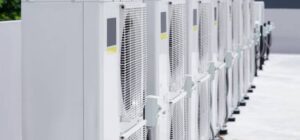Ducted reverse cycle air conditioners provide whole home heating and cooling at the touch of a button. They use heat pumps that transform refrigerant between liquid and gas and back again.
Installed in your roof space, reverse cycle ducted air conditioners quietly deliver warm or cool air via strategically positioned vents. It’s a real investment in your comfort and adds value to your property when it comes time to sell.
Air-purifying filters
 Reverse cycle ducted air conditioning is a whole-home heating and cooling solution that can be installed in new and existing homes. It provides year-round comfort, lower energy bills and a smaller household carbon footprint. The reverse cycle cooling and heating technology is simple – it uses refrigerant to turn hot air into gas, cooling the home. It also helps to remove dust particles from the air, resulting in cleaner, healthier indoor spaces.
Reverse cycle ducted air conditioning is a whole-home heating and cooling solution that can be installed in new and existing homes. It provides year-round comfort, lower energy bills and a smaller household carbon footprint. The reverse cycle cooling and heating technology is simple – it uses refrigerant to turn hot air into gas, cooling the home. It also helps to remove dust particles from the air, resulting in cleaner, healthier indoor spaces.
Reverse cycles are a good option for Melbourne homeowners looking for high indoor comfort and efficiency. This is because they can be used all year round, allowing you to set your preferred temperature at any time of day or night. However, the type of air conditioner you choose will depend on your unique living requirements and the size of your house. It’s vital to ensure the unit is properly sized so it doesn’t use too much energy or waste money by running constantly at full capacity.
The best reverse cycle ducted air conditioning systems are designed for optimal performance and energy efficiency so you can enjoy a comfortable home with minimal impact on your electricity bills. They use air-purifying filters to keep your indoor environment clean and healthy, and they offer a variety of heat and cooling modes that can be tailored to suit your needs.
Ducted air conditioning is ideal for Australian homes because it can deliver a warm, cosy feeling in winter and cool, refreshing air in summer. It’s the most efficient way to heat and cool your home, as it delivers consistent comfort. It is also quiet and energy-efficient, making it a great option for families with young children.
If you’re considering buying reverse cycle ducted air conditioners in Australia, look for an energy-efficient system with a high SEER rating. A higher SEER rating means a more energy-efficient unit, which will help you save money on utility bills in the long run. You can also install a home air purifier to improve indoor air quality further.
Energy efficiency
Unlike traditional split system air conditioners, which are only designed to cool, ducted reverse cycle units have heating and cooling options. This allows them to operate all year round – even in Melbourne’s harsh four-seasons-in-one-day conditions. And they’re also whisper quiet, making them ideal for homes with small children or pets.
Reverse cycles are highly energy efficient because they can provide both heating and cooling in a single unit. This is thanks to a sophisticated refrigeration cycle that uses a special chemical known as refrigerant. The refrigerant changes from a liquid to a gas and then back again, absorbing heat energy as it does so. The heat pump makes This process possible, which moves the refrigerant around your home. It is then circulated through ducts to the rooms in your house, where it is released as cold or hot air.
This makes a ducted system much more energy efficient than other types of air conditioning, especially evaporative cooling, which uses a lot of electricity to evaporate water. With zoning capabilities, you can choose only to cool the rooms you need, cutting down on energy consumption even further.
An appropriately sized ducted system is essential to cool and heat your home efficiently. A qualified installer can conduct an onsite load assessment and calculation to determine your heating and cooling requirements. This will consider your household size, the floor plan of your home, ceiling height and the direction that the rooms face.
When installing reverse cycle ducted air conditioners, your installer should discuss your specific requirements in detail. They’ll consider the size of your home, the number of bedrooms and bathrooms, the floor area and ceiling heights of each room, and whether you have any architectural features or limited roof space that could limit how many ducts can be installed. They will then recommend an appropriately sized system to meet your needs and budget.